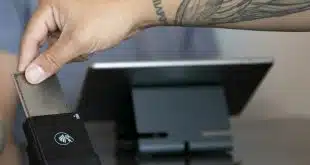Visa Inc.’s U.S. payment card issuers had about 48 million EMV chip cards in the market as of Dec. 31, a Visa executive said Wednesday. And, somewhat surprisingly, about 80% of the small number of U.S. EMV transactions today are coming from small merchants rather than big retailers, which are farther along in deploying EMV card readers.
Most of the EMV cards in circulation are credit cards, with debit card issuance expected to ramp up later, according to Stephanie Ericksen, vice president of risk products at Visa. Ericksen gave an update about the conversion of U.S. card payments to the EMV chip card standard to an audience at the Electronic Transactions Association’s Transact 15 conference in San Francisco. A major EMV deadline looms in October, when liability for counterfeit bank card transactions will shift to merchant acquirers—and ultimately merchants—if they haven’t deployed chip-card-accepting terminals.
The 48 million chip cards Ericksen mentioned represent just 6.3% of the 304 million credit cards and 450 million debit cards Visa’s U.S. issuers had in circulation as of last Sept. 30, the latest date for which figures are available. But issuers, card manufacturers and networks all say the number is increasing rapidly. Payment volume on the small number of EMV debit cards in circulation increased 30% in January over the course of just a month, Ericksen said.
Meanwhile, Ericksen said just over 100,000 U.S. merchant locations were live accepting EMV cards as of Dec. 31, up 26% from Sept. 30. As on the card side, current EMV acceptance locations represent but a tiny fraction of the total U.S. merchant base of about 8 million locations, but chip-enabled terminals are rapidly displacing mag-stripe only terminals. “On the acquiring side, all of the acquirers are actively deploying EMV chip terminals,” Ericksen said.
Ericksen showed her audience a prediction from Boston-based research firm Aite Group LLC that estimated 70% of U.S. credit cards will be converted to EMV chips by the end of 2015 along with 41% of debit cards, while 47% of U.S. terminals will be able to read chip card transactions.
Merchant acquirers and payment card terminal executives have reported that national retail chains and other big merchants are farther along in getting EMV terminals onto their countertops, but small merchants are ahead in getting what EMV terminals they have equipped with the proper software and turning them on to accept chip card transactions ahead of the Oct. 1 liability shift. “Actually, the small merchants today, the Level 4 merchants, account for over 80% of the EMV volume we’ve seen in the market already.” Ericksen said.
The reason for that disparity is that while a big merchant may have dozens or even hundreds of EMV terminals in its stores, integrating them with complex POS systems can take time, so for the time being all they do is read mag stripes. In contrast, an independent sales organization can quickly substitute a small merchant’s old terminal with a new EMV-reading device that’s ready to go, according to Ericksen. “It’s primary because a lot of those [small] merchant solutions are off-the-shelf,” she said.
Much of the impetus for the payment card networks’ push to convert the U.S. to EMV comes from a desire to reduce counterfeit and and lost-and-stolen card fraud, to which mag-stripe cards are highly vulnerable. Counterfeiting accounts for 38% of Visa’s U.S. fraud, with 45% of fraud coming from card-not-present (CNP) transactions, 13% from lost and stolen cards, and 4% from other types of illicit uses.
Many merchants have expressed fears that card-not-present fraud will boom as fraudsters find counterfeiting harder to do because of stronger security from chips at the point of sale. Other countries did sustain increases in CNP fraud after they converted to the EMV standard. For example, in Canada, which began its conversion to EMV more than five years ago, CNP fraud accounted for about 60% of all card fraud before its EMV liability shift but slightly over 80% last year.
But the picture is nuanced, according to Ericksen. Canada’s higher rate of CNP fraud is a result not only of high chip card usage at the point of sale, but also because e-commerce as a share of all retail sales has grown, she said—a position taken by some other observers.
And in Brazil, counterfeiting spiked in 2011 even though 75% of the country’s cards at the time had chips and nearly all of the country’s POS terminals were EMV-enabled, according to Ericksen. The reason for the increase, which has since moderated, is that fraudsters made a concerted effort to target the remaining mag-stripe cards, according to Ericksen. “Fraudsters do learn,” she said.




